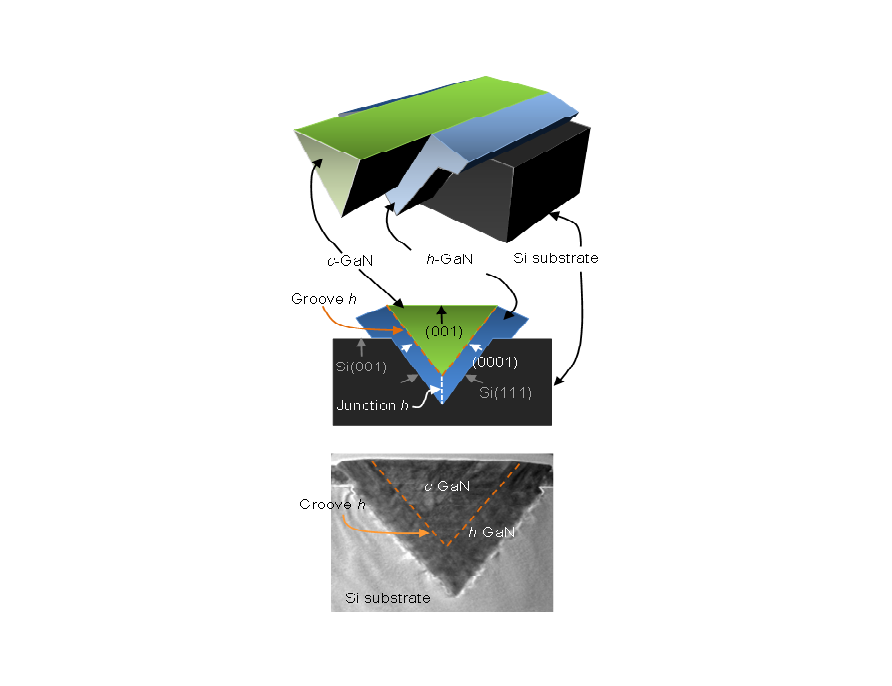Team of LESA Faculty and Graduate Students Awarded US Patent for Inexpensive New Growth Process for Large Area Cubic GaN.
 A team of LESA faculty and graduate students from Rensselaer Polytechnic Institute and University of New Mexico (UNM) were recently awarded U. S. Patent 9,520,472 for «Growth of Cubic Crystalline Phase Structure on Silicon Substrates and Devices comprising the Cubic Crystalline Phase.» This patent was issued on December 13, 2016 to Principal Investigator Steven R. J. Brueck and inventors Sueng-Chang Lee (UNM), Christian Wetzel, Theeradetch Detchprohm (LESA/RPI), and Christoph Stark (LESA/RPI Graduate). The universities are partners in the Center for Lighting Enabled Systems & Applications (LESA) headquartered at Rensselaer Polytechnic Institute in Troy, NY.
A team of LESA faculty and graduate students from Rensselaer Polytechnic Institute and University of New Mexico (UNM) were recently awarded U. S. Patent 9,520,472 for «Growth of Cubic Crystalline Phase Structure on Silicon Substrates and Devices comprising the Cubic Crystalline Phase.» This patent was issued on December 13, 2016 to Principal Investigator Steven R. J. Brueck and inventors Sueng-Chang Lee (UNM), Christian Wetzel, Theeradetch Detchprohm (LESA/RPI), and Christoph Stark (LESA/RPI Graduate). The universities are partners in the Center for Lighting Enabled Systems & Applications (LESA) headquartered at Rensselaer Polytechnic Institute in Troy, NY.
Cubic gallium nitride (GaN) devices hold promise for addressing two long-standing issues that limit the performance of Light Emitting Diodes (LEDs). Poor performance at longer emission wavelengths known as the green gap problem; and poor performance at higher operating current, known as efficiency droop. While GaN devices have excellent performance in the blue regions of the spectrum, these two technical problems limit the overall performance capability for future high-efficiency color-tunable lighting systems and advanced display technologies. By using a «nonpolar facet» of cubic GaN, the RPI/UNM team has demonstrated emission across the visible spectrum from the cubic InGaN/GaN material system that offers significant opportunities for higher efficiency full-spectrum lighting and displays.
GaN crystals can be grown with either cubic or hexagonal (also known as wurtzite) phases. All commercial GaN LEDs are based on hexagonal materials, typically grown on sapphire substrates. “The hexagonal phase typically forms most easily, as it is the lowest energy crystallographic structure. Previous attempts to grow cubic GaN crystal structures have produced poor quality, heavily defected mixed phase materials”, said Prof. Christian Wetzel, Professor of Physics, Applied Physics and Astronomy, and co-inventor of this patent. Professors Wetzel and Brueck are both recognized leaders in the research and development of LED-based solid-state lighting.
“The patented UNM/RPI growth process uses inexpensive Si wafers available in much larger sizes and lower defect densities than sapphire,” stated Prof. Steve Brueck, Principal Investigator and Distinguished Professor Emeritus with the UNM Department of Electrical & Computer Engineering (ECE), the UNM Center for High Technology Materials (CHTM) faculty member, and Director Emeritus of CHTM. The silicon surface is first patterned with an array of nanoscale grooves that lead to a unique, geometrically-driven phase segregation that separates the cubic phase and promotes its growth at the expense of the hexagonal phase GaN material. Additional quantum well layers of InGaAs are added after the pure cubic phase GaN structure has been established to create the light emitting material used to fabricate cubic LEDs.
The UNM/RPI team and other investigators are working to develop a LED manufacturing processes that will allow LEDs to shine brighter and in more colors. This material will be used in applications such as lighting our homes, creating brighter, more colorful and efficient displays, as well as high-efficiency power electronics for improving electric vehicles and renewable energy system performance.
Note: Date of Patent: December 13, 2016, No. 9,520,472
About the Center for Lighting Enabled Systems & Applications (LESA) ERC
Funded primarily by the National Science Foundation (NSF), the LESA ERC is an interdisciplinary, multi-university center developing “Smart Lighting Systems that See and ThinkTM”. The Center engages faculty members, graduate students, research staff, and undergraduates to work on research leading to smart lighting systems with adaptive and controllable properties that will change the way society uses lighting. The Center joins academia, industry, and government in partnership to produce transformational engineered systems, along with engineering graduates who are adept at innovation and primed for leadership in the global economy. The LESA ERC is headquartered at Rensselaer Polytechnic Institute in Troy, NY, and partners with Boston University, The University of New Mexico, and Thomas Jefferson University to achieve its objectives. http://lesa.rpi.edu
About Rensselaer Polytechnic Institute
Rensselaer Polytechnic Institute, founded in 1824, is America’s first technological research university. The university offers bachelor’s, master’s, and doctoral degrees in engineering; the sciences; information technology and web sciences; architecture; management; and the arts, humanities, and social sciences. Rensselaer faculty continue to advance research in a wide range of fields, with an emphasis on biotechnology, nanotechnology, computational science and engineering, data science, and the media arts and technology. The Institute is has an established record of success in the transfer of technology from the laboratory to the marketplace, fulfilling its founding mission of applying science “to the common purposes of life.” For more information, please visit http://www.rpi.edu.
About University of New Mexico
The University of New Mexico is the state’s largest university, serving nearly 35,000 students. As a federally recognized Hispanic-serving institution, UNM represents a cross-section of cultures and backgrounds and is noted for comprehensive undergraduate programs and research that benefits the state and the nation. UNM is also home to a number of world-class research units including the Center for High Technology Materials, Mind Research Network and the Center for Advanced Research Computing.
UNM Center for High Technology Materials (CHTM)
CHTM was one of 5 Centers of Technical Excellence established by the State of New Mexico in 1983. It is internationally recognized as an outstanding research center in photonics and microelectronics.



